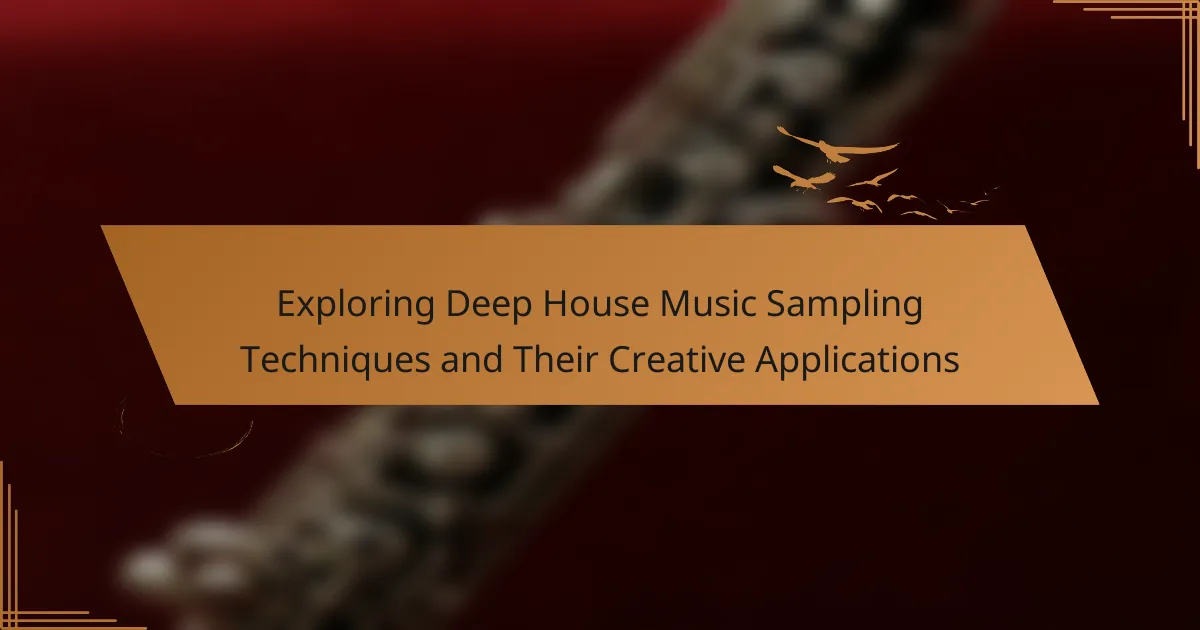Deep house music sampling techniques involve the use of pre-recorded sounds or music excerpts to create new compositions. This article explores various sampling methods, including vinyl sampling, digital sampling, and live sampling, highlighting their contributions to the genre’s unique sound. Key techniques such as chopping, looping, and layering samples are discussed, along with the manipulation of pitch and tempo to enhance creativity. The integration of diverse sound sources, including vocal snippets and instrumental hooks, is emphasized, demonstrating how these elements blend nostalgia with modernity in deep house tracks. Additionally, the use of effects like reverb and delay is examined for their role in enriching the atmospheric quality of sampled sounds.

What are Deep House Music Sampling Techniques?
Deep house music sampling techniques involve the use of pre-recorded sounds or music excerpts in new compositions. These techniques often include chopping, looping, and layering samples to create unique textures. Producers may manipulate samples through pitch shifting and time stretching to fit the desired vibe.
Common sources for samples include vinyl records, digital libraries, and field recordings. The integration of vocal snippets and instrumental hooks is prevalent in deep house tracks. Additionally, effects like reverb and delay enhance the atmospheric quality of the samples.
Sampling in deep house allows for a blend of nostalgia and modernity, connecting past influences with contemporary sounds. This approach contributes to the genre’s rich and diverse sonic palette.
How do sampling techniques influence deep house music production?
Sampling techniques significantly influence deep house music production by providing unique textures and sounds. Producers utilize samples to create distinctive rhythms and melodies. This practice allows for the incorporation of diverse musical elements. Sampling can also evoke nostalgia or cultural references. The use of vocal samples adds emotional depth to tracks. Additionally, sampling techniques enable experimentation with different genres. Historical samples can enhance the authenticity of a deep house track. The manipulation of samples through effects further enriches the sound design. Overall, sampling techniques are essential for innovation in deep house music.
What types of samples are commonly used in deep house music?
Commonly used samples in deep house music include vocal snippets, instrumental loops, and drum hits. Vocal samples often feature soulful or jazzy phrases. Instrumental loops may include piano, guitar, or synth melodies. Drum hits typically consist of kick, snare, and hi-hat sounds. These samples create a rich, textured sound characteristic of deep house. The use of samples enhances the groove and mood of tracks. Many producers source samples from classic soul, jazz, and funk records. This practice connects contemporary music to its historical roots.
How do producers select samples for their tracks?
Producers select samples for their tracks based on several criteria. They often consider the emotional impact of a sample. Samples should evoke a specific feeling that aligns with the track’s theme. Producers also evaluate the sonic quality of the sample. High-quality samples enhance the overall production value.
Another important factor is the genre compatibility of the sample. A sample must fit well within the deep house genre’s characteristics. Producers may also look for originality in samples. Unique samples help distinguish their tracks from others.
Additionally, copyright considerations play a crucial role. Producers must ensure they have the rights to use a sample. This often involves clearing samples legally. Lastly, producers frequently use sample packs or libraries for convenience. These resources provide a wide range of options for selection.
Why are sampling techniques important in deep house music?
Sampling techniques are important in deep house music because they enhance creativity and provide unique soundscapes. These techniques allow producers to incorporate elements from various genres and eras. By using samples, artists can create a rich auditory experience. This practice also connects listeners to the history of music. Notably, deep house often utilizes samples from jazz, soul, and funk. This blending of styles creates a distinctive vibe. Furthermore, sampling can streamline the production process. It enables artists to build tracks quickly while maintaining high-quality sound. Overall, sampling is a foundational aspect of deep house music’s identity.
What role does sampling play in the creative process of deep house music?
Sampling is a fundamental component in the creative process of deep house music. It allows artists to incorporate elements from various genres and eras into their tracks. This technique enriches the sound palette and creates a unique auditory experience. Samples can include vocal snippets, instrumental riffs, or rhythmic patterns. The use of sampling enables producers to pay homage to past influences while innovating new sounds. It also facilitates the layering of textures, enhancing the overall depth of the music. According to a study by the University of Illinois, sampling contributes significantly to genre evolution by merging diverse musical styles. Thus, sampling plays a crucial role in shaping the identity and creativity of deep house music.
How do sampling techniques enhance the emotional impact of a track?
Sampling techniques enhance the emotional impact of a track by incorporating familiar sounds that evoke specific feelings. These techniques allow artists to connect with listeners through nostalgia or shared cultural references. For example, using vocal snippets from classic songs can trigger memories and emotions associated with those tracks. Additionally, sampling can create a layered soundscape that deepens the listener’s experience. This complexity often leads to a more immersive atmosphere in deep house music. Moreover, studies have shown that familiarity with sampled content can increase emotional engagement. According to research by Hargreaves and North, familiarity in music significantly affects emotional responses. Thus, sampling effectively amplifies the emotional resonance of a track.

What are the different methods of sampling in deep house music?
The different methods of sampling in deep house music include vinyl sampling, digital sampling, and live sampling. Vinyl sampling involves using records to extract sounds and loops. This method often adds warmth and character to tracks. Digital sampling utilizes software and hardware to capture audio from various sources. This technique allows for greater flexibility and manipulation of sounds. Live sampling captures real-time audio during performances. This method can create unique and spontaneous musical elements. Each sampling method contributes to the distinct sound and creative expression found in deep house music.
How do digital sampling techniques differ from analog methods?
Digital sampling techniques convert audio signals into numerical data, while analog methods capture sound waves directly. Digital sampling uses discrete values to represent sound, allowing for manipulation and storage on digital devices. Analog methods rely on continuous waveforms, preserving the original sound’s nuances. Digital techniques enable easy editing, layering, and effects application, which can enhance creativity. Conversely, analog methods often impart warmth and character due to their continuous nature. Digital formats allow for lossless compression, while analog can degrade over time. Studies show that digital sampling has revolutionized music production, providing unprecedented flexibility and accessibility.
What tools and software are essential for digital sampling?
Digital sampling requires specific tools and software for effective execution. Essential tools include digital audio workstations (DAWs) like Ableton Live and FL Studio. These DAWs provide robust features for recording, editing, and arranging samples. Additionally, software samplers such as Native Instruments Kontakt and EXS24 are crucial for manipulating audio samples.
Audio interfaces like Focusrite Scarlett help improve sound quality during sampling. MIDI controllers, such as Akai MPK Mini, enhance creativity in triggering samples. Furthermore, plugins for effects processing, like Waves and FabFilter, are important for refining the sound.
These tools and software are widely used in the industry, demonstrating their effectiveness in digital sampling.
How can analog sampling techniques be effectively utilized?
Analog sampling techniques can be effectively utilized by integrating vintage sound sources into music production. These techniques enhance the warmth and character of audio recordings. Producers can use analog synthesizers and tape machines for unique textures. Sampling vinyl records provides rich, authentic sounds that digital sources may lack. Additionally, applying analog effects like tape delay or spring reverb can add depth to tracks. The use of physical equipment encourages hands-on creativity and experimentation. Historical context shows that many iconic tracks in deep house utilized these methods to create distinct sonic identities. Such techniques remain popular in contemporary music for their nostalgic appeal and rich tonal qualities.
What are some innovative sampling techniques used by deep house artists?
Deep house artists employ several innovative sampling techniques. One technique is the use of field recordings. Artists capture sounds from their environment, adding a unique texture to their tracks. Another technique involves layering samples. This creates depth and complexity in the sound. Artists often manipulate samples using pitch shifting. This alters the tone and mood of the music. Time-stretching is also commonly used. It allows artists to change the tempo without affecting the pitch. Additionally, deep house artists frequently utilize vocal chops. These are small snippets of vocal samples that add rhythmic interest. Finally, incorporating samples from diverse genres enhances creativity. It broadens the sonic palette and engages listeners.
How do artists manipulate samples to create unique sounds?
Artists manipulate samples to create unique sounds through various techniques. They use pitch shifting to alter the frequency of samples. This can create higher or lower tones that fit the desired sound. Time stretching allows artists to change the duration of a sample without affecting its pitch. This technique helps in syncing samples to the tempo of a track.
Layering involves combining multiple samples to form a richer sound. Artists may also apply effects like reverb and delay to enhance the texture. Filtering is used to remove certain frequencies, giving samples a distinct character. Additionally, chopping samples into smaller pieces allows for creative rearrangement.
These manipulation techniques are common in genres like deep house. They enable artists to craft original sounds from existing material.
What are the benefits of layering samples in deep house tracks?
Layering samples in deep house tracks enhances the overall sound quality and richness. This technique creates a fuller audio experience by combining multiple sounds. It allows for a more intricate texture, which is essential in deep house music. Layering can also introduce unique rhythms and harmonies that add depth. This method can make a track more engaging and dynamic for listeners. Additionally, it provides producers with the opportunity to experiment with different sonic elements. The use of varied samples can lead to innovative soundscapes. Ultimately, layering samples is a vital technique for achieving a polished and immersive deep house track.

How can sampling techniques be creatively applied in deep house music?
Sampling techniques can be creatively applied in deep house music by incorporating diverse sound sources. Producers can sample snippets from jazz, soul, or funk records to create unique melodies. Layering these samples with synthesized sounds adds depth and texture. Manipulating the pitch and tempo of samples can yield fresh variations. Looping vocal phrases or instrumental hooks creates catchy motifs. Additionally, using field recordings introduces organic elements into the mix. Creative effects, like reverb or delay, enhance the sampled sounds, making them fit the deep house aesthetic. These methods lead to innovative tracks that stand out in the genre.
What are some common creative applications of sampling in deep house?
Common creative applications of sampling in deep house include using vocal snippets, instrumental loops, and environmental sounds. Vocal snippets often serve as hooks or emotional elements in tracks. Instrumental loops can create rhythmic foundations and enhance melodic structures. Environmental sounds contribute to atmospheric depth and texture. These techniques help in crafting unique soundscapes. Sampling also allows producers to pay homage to classic tracks. This practice enriches the genre’s diversity and innovation. Notably, artists like Daft Punk have utilized sampling effectively in their work. Their approach showcases the transformative power of sampling in creating new music.
How can sampling be used to create a signature sound?
Sampling can be used to create a signature sound by incorporating unique audio clips into music production. Producers select specific samples that resonate with their artistic vision. These samples can include snippets from other songs, spoken word, or environmental sounds. By manipulating these samples through techniques like pitch shifting and time stretching, a distinctive audio texture is formed. This approach allows for the blending of various genres and influences. Historical examples include Daft Punk and their innovative use of sampling in house music. Their signature sound emerged from carefully curated samples, establishing a recognizable style. Ultimately, sampling fosters creativity and individuality in music production.
What are the best practices for incorporating samples into original compositions?
The best practices for incorporating samples into original compositions include selecting high-quality samples that enhance the composition. Use samples that fit the genre and mood of the track. Layer samples with original sounds to create a unique texture. Ensure the samples are in key and tempo with the composition for cohesion. Apply effects to modify samples, making them distinct from their original context. Respect copyright laws by obtaining necessary licenses for samples. Consider the arrangement to integrate samples seamlessly into the composition. These practices enhance creativity and maintain originality in music production.
What challenges do producers face when using sampling techniques?
Producers face several challenges when using sampling techniques. One major challenge is copyright issues. Many samples are protected by copyright laws, requiring producers to obtain licenses. Failure to do so can result in legal consequences. Another challenge is the quality of samples. Low-quality samples can negatively impact the overall sound of a track. Additionally, finding unique samples can be difficult. Many producers rely on the same popular sources, leading to a lack of originality. Furthermore, integrating samples into original compositions can be complex. This process often requires technical skills and creativity to ensure a cohesive sound. Lastly, the creative limitations of sampling can restrict artistic expression. Some producers may feel confined by the samples they choose to use.
How can copyright issues affect sampling in deep house music?
Copyright issues can significantly affect sampling in deep house music. Sampling involves using portions of existing recordings in new compositions. When artists sample without permission, they risk legal action from the original creators. This can lead to costly lawsuits and potential financial losses. Additionally, unauthorized samples may result in the withdrawal of music from streaming platforms. The need for proper licensing can limit creative freedom. Artists must navigate complex copyright laws to ensure compliance. Failure to do so can hinder the distribution and promotion of their work.
What are some common pitfalls to avoid when sampling?
Common pitfalls to avoid when sampling include not clearing samples legally. Failing to obtain permission can lead to legal issues. Another pitfall is using overly recognizable samples. This can detract from originality and creativity. Additionally, neglecting to consider the context of the sample can result in a disjointed sound. Poor quality samples can also undermine the final product. Lastly, overusing samples can lead to a lack of innovation in music. Each of these pitfalls can negatively impact the quality and reception of the music.
What practical tips can enhance the use of sampling techniques in deep house music?
Use high-quality samples to enhance deep house music. Quality samples improve overall sound clarity. Explore various genres for diverse sampling options. Incorporating elements from jazz, funk, or soul enriches the music. Experiment with pitch shifting to create unique textures. Adjusting pitch can transform a sample’s character. Layer samples to build depth in the mix. Combining different sounds creates a fuller auditory experience. Utilize effects like reverb and delay creatively. These effects can add atmosphere and space. Keep the tempo consistent to maintain groove. A steady tempo is crucial in deep house music. Regularly analyze your mix for balance and clarity. This practice ensures all elements are well-integrated.
Deep house music sampling techniques involve the use of pre-recorded sounds to create unique compositions through methods such as chopping, looping, and layering. This article explores how sampling influences deep house production, highlighting the emotional impact, common types of samples, and the selection process for producers. It also examines the importance of sampling in enhancing creativity and sound design, as well as the challenges and best practices associated with its use. Additionally, innovative sampling methods and the role of technology in digital sampling are discussed, providing a comprehensive understanding of sampling’s role in deep house music.
